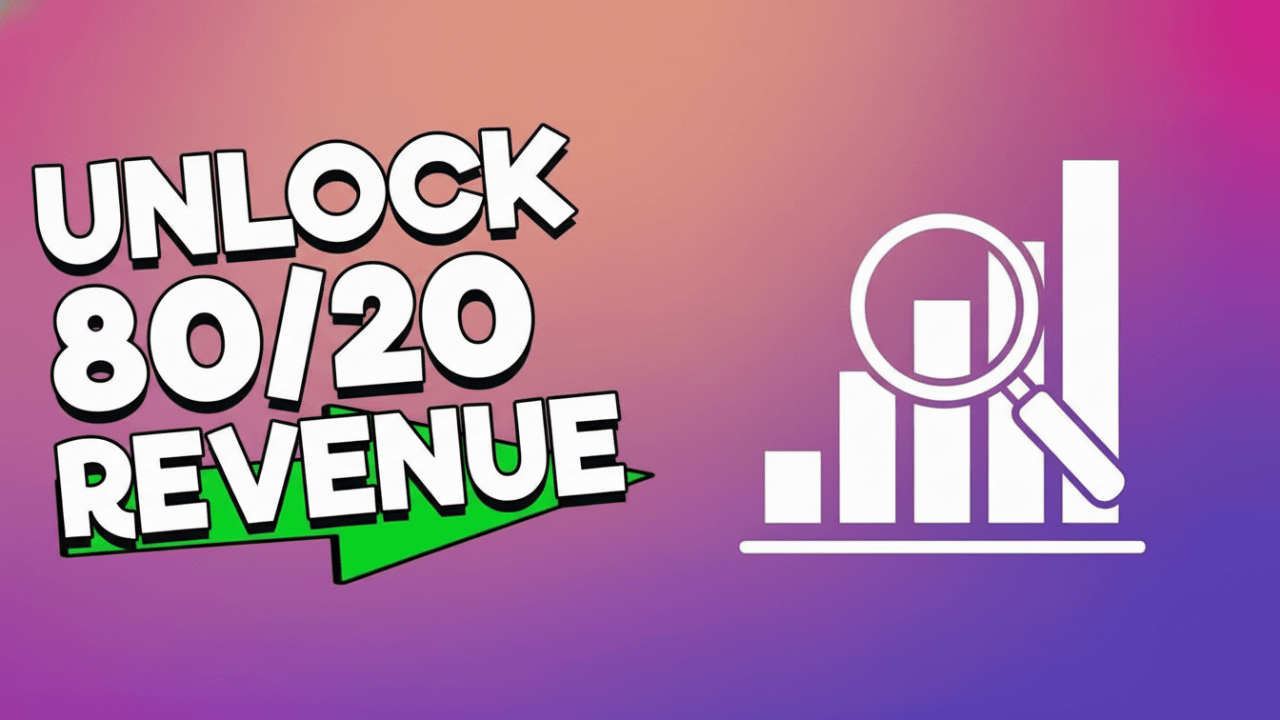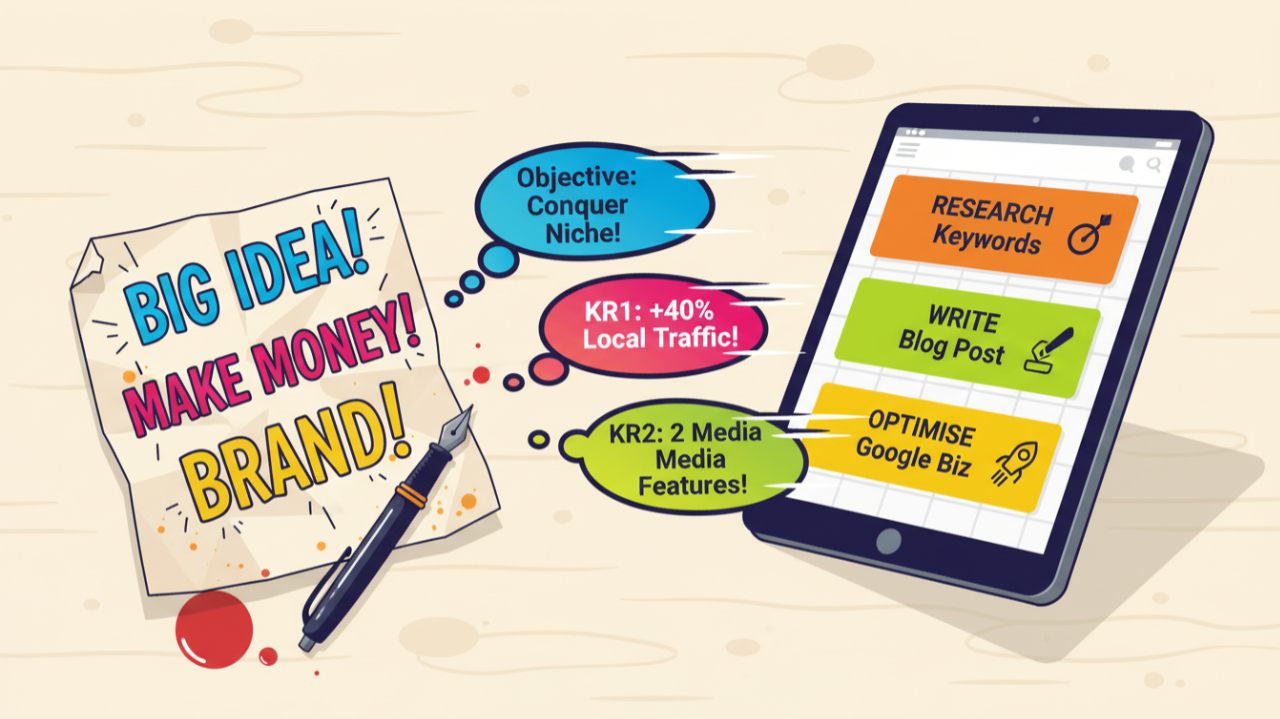The Strategic Plan Graveyard: 5 Signs Your Strategy Is Doomed to Fail
Here we go. Let's talk about that strategic plan. You know the one. The one you and maybe a couple of your key people spent weeks, maybe even months, painstakingly putting together. There were whiteboards involved. So many Post-it Notes. You felt a real sense of accomplishment when you finally saved that final version, probably named something like ‘Company_Strategy_FINAL_v2.7_final_FINAL.docx’.
And then… what happened?
If you’re anything like the hundreds of small business owners I’ve spoken to over the years, not a lot. The document was emailed around, maybe discussed in one big meeting, and then it found a quiet, comfortable home in a shared drive folder, never to be seen again. It’s now gathering digital dust, a well-intentioned ghost of ambitions past.
It’s a frustratingly common story. You pour all that energy into charting a course for the future, only for the day-to-day chaos of running a business to completely take over. The urgent always seems to shout louder than the important. But here’s the thing. The problem often isn’t the team, the market, or a lack of good intentions. The problem is usually baked right into the plan itself.
Before you start looking for a new template or a fancy piece of software to fix things, it’s worth doing a bit of an honest self-diagnosis. Sometimes, just recognising the flaws in the architecture is the most important first step. So, grab a cup of tea, pull up that old plan if you can find it, and let’s walk through the five most common tell-tale signs that your strategic plan was always destined to become a decorative shelf filler.
Sign 1: The Plan Is a Doorstop in Disguise
I once saw a strategic plan for a company of fifteen people that was over sixty pages long. Sixty. It had appendices, a glossary of terms, and charts so complex they looked like the schematics for a nuclear submarine. The founder was incredibly proud of it. And guess how many people in his company had actually read it, let alone understood it? You guessed it. Zero.
This is probably the most common trap. We fall in love with the idea of being ‘strategic’ and think that means it has to be long, dense, and full of impressive-sounding business jargon. We talk about ‘synergising core competencies’ and ‘leveraging paradigm shifts’ until the words lose all meaning. The result is a document that is completely impenetrable to the very people who are supposed to be implementing it.
Your team, especially in a small business, doesn’t have time to decipher a corporate thesis. They need clarity, not complexity. They need to be able to glance at the plan and know, instantly, what the main goal is.
Think about it this way. If you can't explain your strategy to someone in the time it takes for a lift to go up three floors, it’s too complicated. The beauty of a great strategy isn't in its length or its vocabulary; it's in its elegant simplicity. It should be a compass, not an encyclopaedia. A compass has one job: to point north. It’s simple, clear, and unbelievably useful when you’re lost. An encyclopaedia contains all the information in the world, but it’s useless when you need to make a quick decision about which way to turn.
The benefits of simplicity are huge. A simple, focused plan is memorable. Your team can hold the key objectives in their heads. It’s inspiring. People can see exactly how their work connects to the big picture. And most importantly, it’s actionable. It gives people a clear filter for making decisions. When a new opportunity comes up, they can ask, "Does this move us closer to our one big goal?" If the answer is no, it's easier to say no.
So, take a hard look at your plan. Is it a compass or an encyclopaedia? If it’s longer than a few pages, I can almost guarantee it’s not being used. The goal should be a plan so clear and concise that you could print it on a single A4 page and stick it on the wall for everyone to see.
Sign 2: The Mystery of Who’s Doing What
The second sign your plan is gathering dust is when accountability is as vague as a weather forecast for next month. You’ll see goals assigned to ‘The Marketing Team’ or, the absolute classic, ‘Everyone’.
Let me tell you something I've learned the hard way: if everyone is responsible, no one is responsible. It’s a comforting illusion that diffuses responsibility so thinly that it effectively vanishes. It allows individuals to assume someone else is picking up the slack. "Oh, I thought Dave was handling that." "Wasn't that Sarah's project?" It's the corporate version of the bystander effect.
A strategic plan without clear, named owners for each objective is just a wish list. It’s a collection of nice ideas with no engine to drive them forward. For a goal to become a reality, a single human being needs to feel a deep, personal sense of ownership for it. Their name has to be next to it. They need to be the person who lies awake at 3 am thinking about it.
This isn't about creating a culture of blame. Quite the opposite. It’s about creating a culture of clarity and empowerment. When you assign a specific person to a specific outcome, you’re not just making them responsible; you’re giving them the authority and the trust to make it happen. You’re saying, "We believe you are the right person to lead this charge."
And it doesn’t stop with just putting a name in a box. It requires a rhythm of regular check-ins. This is where so many small businesses drop the ball. In a small team, it’s easy to assume everyone knows what’s going on because you all sit in the same room or are on the same Slack channel. But informal chats by the kettle aren’t a substitute for structured accountability.
Having a simple, regular meeting, maybe just 20 minutes every week or fortnight, where each goal owner gives a quick traffic light update (Green: on track, Amber: some issues, Red: we have a problem) is transformative. It creates a gentle, positive pressure to make progress. It provides a forum for people to ask for help when they’re stuck. And it keeps the strategy front and centre, week in and week out. Without that rhythm, even the best intentions will fade within a month.
Sign 3: The Goals Are Made of Fog
Have a look at the goals in your strategic plan. Do they sound something like this?
- "Improve customer satisfaction."
- "Increase our brand awareness."
- "Become the leading provider in our niche."
- "Foster a more innovative culture."
These all sound lovely, don’t they? They are positive, aspirational, and completely, utterly useless. They are what I politely call ‘sh*t goals’. They feel good to write, but they are impossible to act on because they are impossible to measure.
How do you know when you’ve ‘improved’ customer satisfaction? What does that even look like? How much is enough? If you get one fewer complaint this quarter than last, have you succeeded? What about brand awareness? How do you measure that without a multi-million-pound marketing budget?
If you can't measure it, you can't manage it. And if you can't manage it, you certainly can't achieve it. Progress becomes a matter of opinion or gut feel, and that’s a dangerous way to run a business. You have no idea if the actions you’re taking are actually working. It’s like trying to win a football match without a scoreboard. You’re all running around, kicking the ball, but you have no idea if you’re winning, losing, or drawing. It’s exhausting and demoralising.
This is where clear Key Performance Indicators, or KPIs, and actionable milestones come in. They turn the fog into something solid you can actually get your hands on.
Let’s translate those foggy goals:
- Instead of "Improve customer satisfaction," try: "Increase our Net Promoter Score from 45 to 60 by the end of the year."
- Instead of "Increase our brand awareness," try: "Secure five guest articles in industry publications and increase our LinkedIn follower count by 50% in the next six months."
- Instead of "Become the leading provider," try: "Achieve a 25% market share in the Northwest region for our core product within three years, as measured by our annual customer survey."
See the difference? Suddenly, the goal is a concrete destination. You have a number to aim for and a deadline. This allows you to break it down into smaller, actionable milestones. To get that Net Promoter Score up, maybe a Q1 milestone is to implement a new customer feedback system. A Q2 milestone is to retrain the team based on that feedback. Now you have a plan. Now you can track progress.
When you hit one of those milestones, you get to celebrate a small win. That celebration builds momentum and energy, which is the fuel that keeps a long-term strategy alive. Vague goals offer none of that. They just leave your team feeling like they're on a treadmill, running hard but never actually getting anywhere.
Sign 4: The Plan Lives in an Ivory Tower
This is a subtle one, but it's incredibly powerful. It’s when your strategic plan feels like a beautiful, abstract piece of art hanging in a gallery, completely disconnected from the messy, chaotic workshop of your daily business operations.
The plan talks about ‘blue sky thinking’ and ‘market disruption’, but your team is spending its day dealing with a buggy ordering system, chasing late invoices, and answering the same three questions from customers over and over again. The strategy exists in a parallel universe to the work that actually gets done.
When this disconnect happens, the plan quickly becomes irrelevant. It’s seen as a ‘management exercise’ that has no bearing on real life. People pay lip service to it in meetings, but when they’re back at their desks, they revert to doing things the way they’ve always been done. Why? Because the plan hasn’t been translated into their world. It hasn’t answered the most important question for any employee: "What does this mean for me on Tuesday morning?"
Operationalising your strategy is the critical step of bridging this gap. It’s about weaving the threads of your strategic goals into the very fabric of your day-to-day processes.
How do you do that?
First, you talk about it. Constantly. In your weekly team meetings, don’t just talk about the to-do list for the week. Frame it around the strategy. "Okay, our big goal this quarter is to reduce customer churn by 10%. What are the three things we're doing this week to move that needle?" This forces everyone to connect their daily tasks to the bigger picture.
Second, align your systems and processes. If a strategic goal is to be more responsive to customers, but your internal process for handling inquiries involves three different people and a spreadsheet, you have a problem. Your operations are fighting your strategy. You need to redesign the process to support the goal.
Third, connect it to how you manage people. Even in a small team with informal reviews, you can align your conversations around the strategy. Instead of just asking "How are things going?", ask "How are you contributing to our goal of expanding into the new service line? What support do you need to do that better?" This makes the strategy personal and developmental, not just a set of corporate targets.
When your strategy informs your daily huddles, your weekly priorities, and your monthly reviews, it stops being a dusty document. It becomes the living, breathing heartbeat of the business.
Sign 5: It Was Carved in Stone
The world does not stand still. And in the UK small business landscape of the last few years, that’s been an understatement. We’ve had a pandemic, supply chain chaos, inflation, political uncertainty… things change, and they change fast.
The final tell-tale sign of a doomed strategic plan is that it’s rigid. It was created in a workshop one January afternoon and then treated as an unchangeable set of commandments for the rest of the year. This is a recipe for disaster. A plan that cannot adapt is a plan that will be ignored, because it will quickly become obsolete.
Imagine setting off to drive from London to Edinburgh with a printed map from 2010. You wouldn't do it, would you? You’d use a live GPS app that reroutes you around traffic jams, road closures, and accidents. Your strategic plan needs to be more like a GPS and less like an old paper map.
Sticking rigidly to an outdated plan isn't a sign of discipline; it’s a sign of blindness. It leads to wasted effort, missed opportunities, and a growing sense of frustration as the team tries to hit targets that no longer make sense in the current reality.
A healthy strategy is not a static document; it’s a dynamic process. It requires a culture of ongoing review and a willingness to course correct. This doesn’t mean you should abandon your core vision every time you hit a bump in the road. Your ultimate destination, your 'why', can remain constant. But the route you take to get there absolutely must be flexible.
The best way to build this in is, again, through a regular rhythm. A quarterly strategy review is a fantastic habit to get into. This isn’t a massive, two-day offsite meeting every time. It can be a focused, two-hour session with your key people. You put the plan up on the screen and ask three simple questions for each goal:
- What did we say we would do?
- What did we actually do?
- What have we learned, and what should we do next quarter?
This process gives you permission to be agile. It allows you to say, "You know what, that initiative isn’t working, let’s kill it and try something else." Or, "A new competitor has just appeared, we need to adjust our marketing goal to counter them." This isn’t failure. This is smart, responsive leadership. It keeps the plan relevant, alive, and, most importantly, useful.
From Dust to Dynamic
So there you have it. The five horsemen of the strategic apocalypse: a plan that’s too complex, has no clear owners, contains foggy goals, is disconnected from daily life, and is too rigid to survive contact with reality.
Take a moment and be honest with yourself. How many of those signs does your current plan show? One? Three? All five? Don't be disheartened if it's more than you'd like. Recognising the problem is more than half the battle. You're already ahead of the thousands of other businesses who just let their plans die a quiet death in a forgotten folder.
The truth is, the problem isn't that strategic planning is a waste of time. The problem is that the way most of us are taught to do it is fundamentally broken, especially for lean, fast-moving small businesses. You don’t need a more complicated document; you need a simpler, more dynamic system. You need a way to build a plan that is clear, accountable, measurable, integrated, and adaptable from day one.
It's about moving from a static document that gathers dust to a living system that drives real, tangible results. It's about turning that lofty business vision into meaningful daily action. If you're ready to stop writing plans that get ignored and start building a system that actually works, we've spent a lot of time thinking about exactly how to do that. You can see how we turn your Business Vision Into Action here:
https://newwaygrowth.com/Business-Vision-Into-Action.
Additional Resources:
For further material on related topics, consider exploring the following:
Ready to Break Free From the Fog of Daily Chaos?
Your vision is too important to let it slip away. Don’t stay stuck, watching your strategy gather dust on the whiteboard while urgent tasks take over. If you’re serious about transforming your business vision into purpose-driven action and real results, let’s talk.
Take the first step:
Book a no-obligation, honest conversation with Adam at New Way Growth. No sales pitches, just a genuine chat about your goals and the obstacles holding you back.
Reclaim your team’s momentum, energy, and confidence.
Contact us now and let’s turn your business strategy into unstoppable progress.
Phone: 0330 311 2820
We look forward to helping you discover your unique path to growth, strategies that fit you - not the other way round.
Pay It Forward! Sharing Is Caring!











